How a two-piece drawn and wall-ironed food can is made
二片金屬?zèng)_拔罐的制造
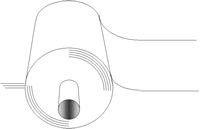 1. Aluminium or steel strip arrives at the can manufacturing plant in large coils.
1. Aluminium or steel strip arrives at the can manufacturing plant in large coils.鋁或鋼板以大卷的形式運(yùn)到制罐廠
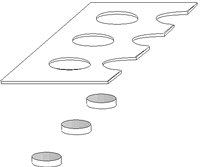 2. The strip is lubricated with a thin film of liquid and then fed continuously through a cupping press, which blanks and draws thousands of shallow cups every minute.
2. The strip is lubricated with a thin film of liquid and then fed continuously through a cupping press, which blanks and draws thousands of shallow cups every minute. 金屬片經(jīng)過一層薄薄的液體膜潤(rùn)滑然后進(jìn)入連續(xù)沖拔機(jī),每分鐘沖拔出數(shù)千只金屬淺杯
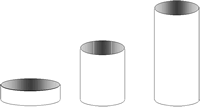 3. Each cup is rammed through a series of tungsten carbide rings. This is the drawing and ironing process which redraws the cup to a smaller diameter and thins the walls, whilst increasing the height.
3. Each cup is rammed through a series of tungsten carbide rings. This is the drawing and ironing process which redraws the cup to a smaller diameter and thins the walls, whilst increasing the height. 每只杯再經(jīng)過一系列碳化鎢環(huán)的沖壓,。這是拉伸和碾平杯壁的過程,,以形成更細(xì)的直徑、更薄的壁和增加罐子的高度
 4. Trimmers remove the surplus irregular edge and cut each can to a precise specified height. The surplus material is recycled.
4. Trimmers remove the surplus irregular edge and cut each can to a precise specified height. The surplus material is recycled.整理機(jī)去除多余的飛邊,,并把杯子精確地切成要求的高度,,多余的材料被回收
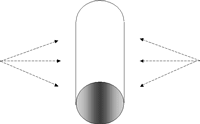 5. The trimmed can bodies are passed through highly efficient washers and then dried. This removes all traces of lubricant in preparation for coating internally and externally.
5. The trimmed can bodies are passed through highly efficient washers and then dried. This removes all traces of lubricant in preparation for coating internally and externally.
整理過的罐身經(jīng)過高速清洗機(jī)并干燥。這一步驟是為了去掉潤(rùn)滑液殘留為內(nèi)外涂層做準(zhǔn)備
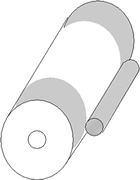 6. The cans are coated externally by passing them under a waterfall of clear lacquer which protects the surface against corrosion.
6. The cans are coated externally by passing them under a waterfall of clear lacquer which protects the surface against corrosion.罐子通過一個(gè)瀑布似的清漆噴霧進(jìn)行外涂層,,以達(dá)到防銹的目的
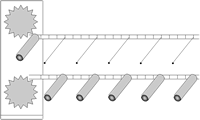 7. Lacquered external surfaces are dried in an oven
7. Lacquered external surfaces are dried in an oven罐外的漆膜通過烘箱干燥
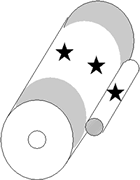 8. The cans are passed through a flanger, where the tops of the cans are flanged outwards to accept the ends after the cans have been filled.
8. The cans are passed through a flanger, where the tops of the cans are flanged outwards to accept the ends after the cans have been filled.罐子通過一個(gè)刮板形成頂部折邊,,以便罐裝后與罐底封合
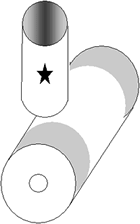 9. The cans are passed through a beader, where the walls of the cans have circumferential beads formed in them to give added strength.
9. The cans are passed through a beader, where the walls of the cans have circumferential beads formed in them to give added strength.
罐子通過卷邊器在罐壁上加筋以加強(qiáng)罐體的強(qiáng)度
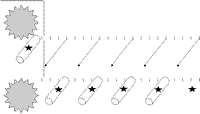 10. Every can is tested at each stage of manufacture. At the final stage they pass through a light tester which automatically rejects any cans with pinholes or fractures.
10. Every can is tested at each stage of manufacture. At the final stage they pass through a light tester which automatically rejects any cans with pinholes or fractures. 每個(gè)罐子都經(jīng)過制造高的檢測(cè),。最后罐子通過一個(gè)光學(xué)檢測(cè)器可以自動(dòng)剔除有針孔或爆裂的罐子
 11. The inside of each can is sprayed with lacquer.
11. The inside of each can is sprayed with lacquer.
This special lacquer is to protect the can itself from corrosion and from any possibility of interaction between the contents and the metal.
每個(gè)罐子的內(nèi)部都噴一種清漆,。這種特殊的涂層是為了防銹以及防止內(nèi)容物對(duì)金屬材料的腐蝕
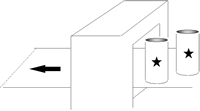 12. Lacquered internal surfaces are dried in an oven.
12. Lacquered internal surfaces are dried in an oven. 內(nèi)層漆膜通過一個(gè)烘道干燥
 13. The finished can bodies are then transferred to the warehouse to be automatically palletised before despatch to the filling plant.
13. The finished can bodies are then transferred to the warehouse to be automatically palletised before despatch to the filling plant.完成的罐身運(yùn)到倉(cāng)庫(kù)并自動(dòng)碼垛等待送入灌裝




